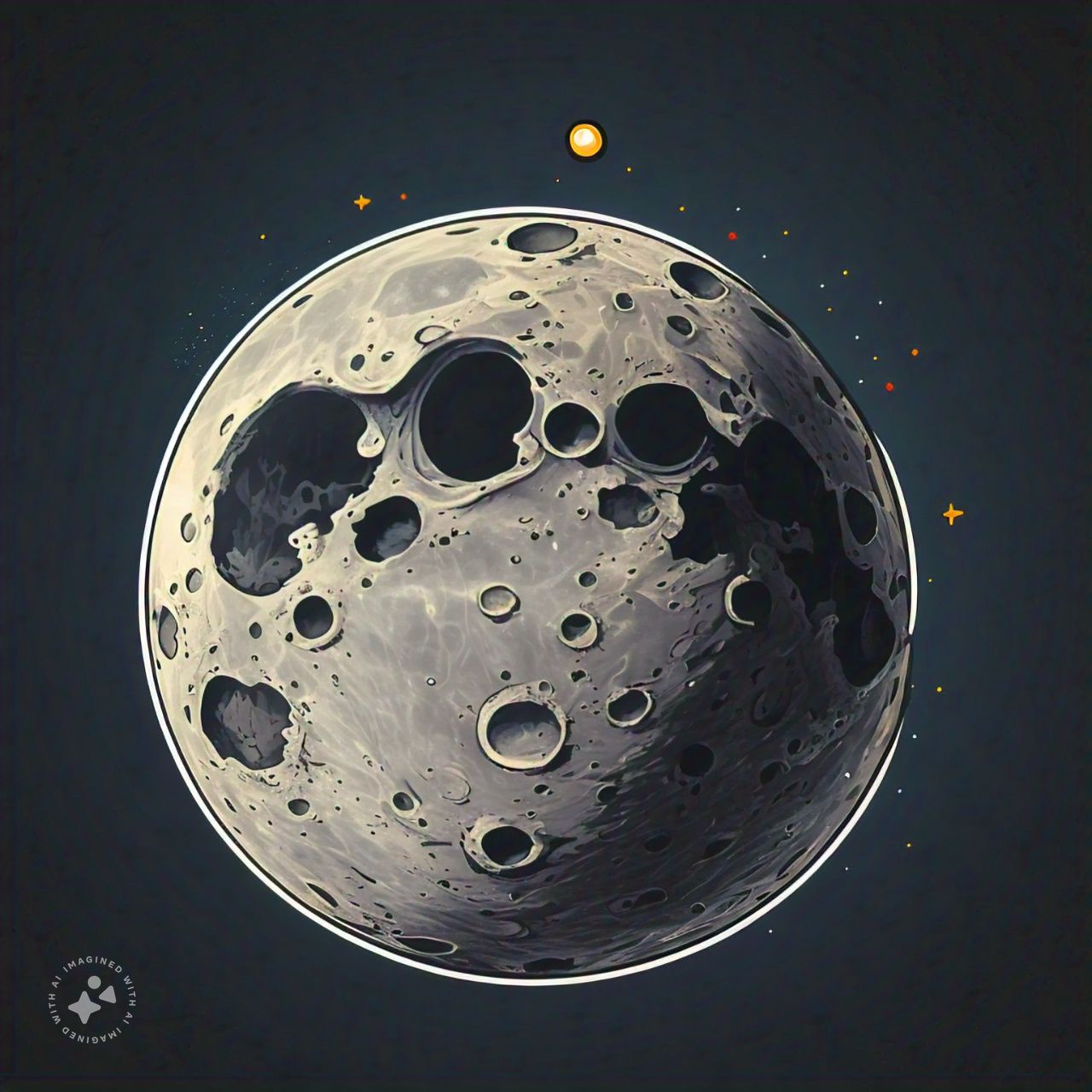Have you ever looked at the moon and noticed all those bumpy spots and deep round holes on its surface? These spots are called craters, and they make the moon look like a giant golf ball! But why does the moon have so many craters? Let’s dive into the mystery of moon craters and find out how they formed and why they’re so important to scientists.

What Are Moon Craters?
A crater is a round, bowl-like hole on the surface of a planet, moon, or asteroid. The moon has thousands of craters, which are spread across its surface. They vary in size – some are small, just a few metres wide, while others are massive and can be hundreds of kilometres across!

How Do Craters Form on the Moon?
Craters form when objects from space, such as meteoroids, asteroids, or comets, smash into the moon’s surface. Imagine throwing a stone into the sand – it creates a little dent or hole. In a similar way, when a space rock collides with the moon, it creates a big hole called an impact crater. The size of the crater depends on the size, speed, and angle of the rock hitting the moon. Bigger rocks make larger craters, while smaller rocks make smaller craters.

Let’s look at what happens during a collision:
- Impact: When a meteoroid or asteroid hits the moon, it travels at an incredible speed. Most space rocks hit the moon at speeds of 12 to 72 kilometres per second! That’s much faster than a bullet from a gun.

- Explosion: Because of the high speed, the impact releases a huge amount of energy, causing an explosion on the moon’s surface. This explosion throws up pieces of moon rock, dust, and debris.

- Crater Formation: The explosion creates a round hole in the surface, which we see as a crater. The larger and faster the rock, the bigger the crater.

- Ejecta: After the impact, some of the ejected material lands around the crater, forming a raised rim. This debris around the crater is called ejecta.

Why Does the Moon Have So Many Craters?
The Earth also gets hit by meteoroids and asteroids, but it doesn’t have as many craters as the moon. Why is that?
- No Atmosphere: The moon doesn’t have an atmosphere like Earth. Earth’s atmosphere acts like a shield, burning up many space rocks before they can reach the ground. This is why we see “shooting stars” – they’re actually meteoroids burning up in the atmosphere! But the moon has no atmosphere, so space rocks hit its surface directly and leave craters.

- No Weathering or Erosion: On Earth, we have wind, rain, and plants that slowly wear down rocks and change the surface. Over time, this makes craters and other features less visible. The moon doesn’t have any weather or water to change its surface, so craters stay there for millions or even billions of years.

- Lack of Geological Activity: Earth has active volcanoes and tectonic plates that move and reshape its surface. The moon is geologically inactive, meaning there are no volcanoes or earthquakes to change its surface. This inactivity has allowed craters to stay nearly the same for billions of years.

Famous Craters on the Moon
The moon has thousands of craters, but some are particularly well-known. Here are a few:
- Tycho Crater: One of the most famous craters, Tycho is about 85 kilometres wide and has bright rays of ejected material spreading out from it.

- Copernicus Crater: Named after the famous astronomer Copernicus, this crater is about 93 kilometres wide and is located in the moon’s northern hemisphere.

- Clavius Crater: One of the largest craters on the moon, Clavius is 225 kilometers across and can be seen with binoculars!

What Can We Learn from Moon Craters?
Scientists study moon craters to understand the history of the moon and the solar system. Here are some fascinating things we’ve learned:
- Age of the Moon: By studying the number and size of craters, scientists can estimate how old different parts of the moon’s surface are. More craters usually mean that part of the moon’s surface is very old.

- Impact History: The moon’s craters tell us about the history of impacts in the solar system. By studying moon craters, scientists can also learn more about Earth’s impact history, which helps us understand how life on Earth has evolved.

- Space Rocks: Moon craters provide clues about the types of rocks that hit the moon, where they come from, and what they’re made of. Some rocks may come from comets, while others are from asteroids.

- Earth-Moon Connection: Studying craters on the moon helps us understand Earth better. Since Earth and the moon are close neighbours, they’ve both been hit by space rocks over billions of years. By studying the moon, scientists can learn more about Earth’s past as well.

Making a Moon Crater at Home!
Would you like to see how craters form? Here’s a simple experiment you can try at home!
What You’ll Need:
- A tray or pan
- Flour or sand
- Cocoa powder (for a darker layer)
- Small pebbles or marbles
Steps:
- Fill the tray with flour or sand to create a smooth surface.
- Sprinkle a thin layer of cocoa powder over the top.
- Drop a pebble or marble from a height onto the surface. Watch as it creates a “crater”!

When the pebble hits, it will make a dent in the surface, similar to how a space rock makes a crater on the moon.
Did You Know?
- Some craters on the moon have been there for over 3 billion years!
- The far side of the moon, which we don’t see from Earth, has more craters than the side we see.
- The largest known crater in the solar system, the South Pole-Aitken Basin, is on the moon and is about 2,500 kilometres wide and 13 kilometres deep!
Conclusion
The moon’s craters are like its “battle scars,” showing us the story of its journey through space. These craters, formed by meteoroid impacts over billions of years, tell scientists about the history of the moon and the solar system. Without an atmosphere or weather to change its surface, the moon’s craters remain almost the same, offering us a unique window into the past. Next time you gaze up at the moon, remember each crater has its own story – a story written by rocks from outer space that shaped the moon into what we see today!
For more interesting articles, please visit www.kidzherald.com





